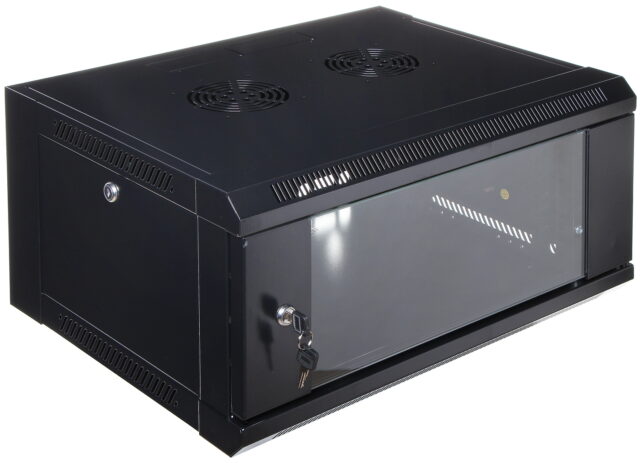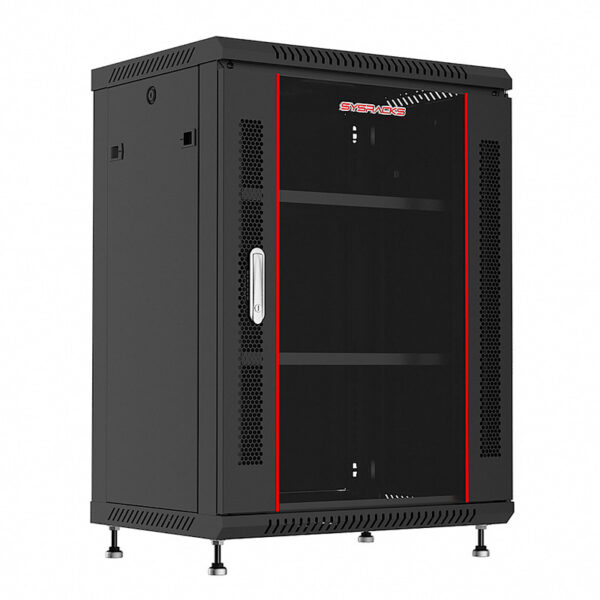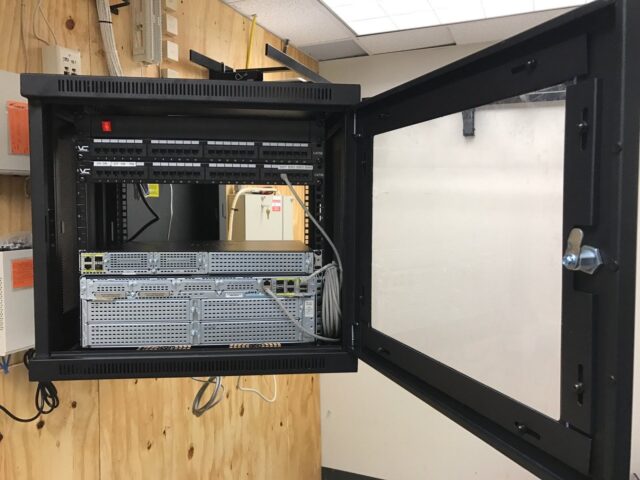
Server furniture is frequently chosen for an installation in spacious data centers. However, in some cases, users do not have much space to accommodate big floor-standing cabinets. Modern manufacturers offer convenient alternatives for such purposes.
A wall-mount rack is a comfortable and compact solution for small premises. These are metal constructions with removable side walls and perforated doors. They are mounted to vertical surfaces with high-load dowels or support cabinets with special hanging constructions. However, this feature limits furniture loading capacity since supporting mechanisms can carry a particular weight.
Benefits of Hanged Server Cabinets

The main advantages of hanging furniture are determined by its specifics of installation. These include:
- Space ergonomics. Being fastened to the wall, cabinets leave floor space, providing more space for other objects’ accommodation. Thus, such models are ideal for small rooms and home offices.
- Perfect equipment allocation. Multi-layers cabinets with special fasteners allow for housing different components and placing them compactly.
- Security. Equipment is secure inside metal enclosures. Durable materials are used for furniture production to guarantee shock resistance. Locks and latches are used on doors. Moreover, if you hang the cabinet high, no one will be able to reach it physically.
- Convenient enclosures. When buying a server cabinet, users already have all the needed slots. Bodies are equipped with holes for cable wiring, fan mounting, and other tech slots.
- Inner environment control. It is possible to create an optimal environment inside cabinets since the walls are solid, and unused slots are plugged with blanking panels. Thus, it is easy to maintain and manage a temperature parameter.
- Manufacturers produce models of diverse sizes, which allows for selecting an appropriate rack for any network system.
- There are several techniques for mounting. It is possible to select appropriate solutions for installation on different types of surfaces, including concrete and drywall.
Due to the fastening on walls, this category of server furniture has found wide application in stores, banks, medical establishments, hospitals, cafes, and other public spaces, as well as home offices. Reliable metal bodies protect hardware from all kinds of external impacts.
The Best Location for Wall Cabinet Installation

When choosing the best place for fastening your server wall cabinet, consider the wall type. Basically, it is possible to mount furniture on any surface, but if you choose drywall, remember that the weight capacity will be lower. The drywall is softer, so you’ll have to sacrifice weight in this case. Concrete walls are more durable and will be the best practice to install your server product.
TOP Types of Fasteners for Rack Mounting
Several types of fasteners are used for wall-mount rack installation. Tech specialists use the following tools:
- studs are suitable for fastening cabinets of over 16 inches in width. Two studs will perfectly support such cabinets.
- high-load dowels that can carry up to 105 lbs.
- drywall anchors.
In most cases, fasteners are attached to cabinets. However, if you don’t have a set of fasteners, approach the issue of selecting appropriate tools responsively since equipment security and integrity depend on this. Note that the bigger the carrying weight, the thicker anchors are required. So, calculate the system weight to determine suitable anchors and find out the thickness of holes to be drilled in the wall.
Hardware Installation in a Hanged Cabinet

If you plan to mount hardware vertically, it is recommended to fasten mounting rails, rest chassis ears, and install crews. Do it when the mount is on the wall. In this case, you won’t have to disassemble a whole system once some component replacement is needed.
Most models of hanged cabinets have square hole rails, meaning that technicians will need cage nuts. Make sure that nuts and chassis ears are compatible. Install cage nuts into square holes and thread a screw through to mount hardware.
If you have a lightweight system, there is no need to add rails since the staff can fasten devices with their own ears.
How to Install Servers into Wall Racks?
Server mounting requires particular attention since there are certain specifics. First of all, note that server chassis ears are not suitable for server installation. They can only be used to lock servers into place. When dealing with servers, technicians use L brackets or rails.
Another remark relates to the choice of server rails. If your construction has only front mounting rails, then you need 2-post server rails. 4-post server rails are required for bodies with 4 points of support. The first class is used for light systems, while the latter is suitable for heavy hardware.
Now, you can proceed to server installation. Here’s a step-by-step guide on this process to ensure reliable and safe housing:
- Attach inner rails to a server using shoulder screws before installation.
- Check the shoulder screws presence on the server chassis sides. Keyhole slots on the outer rail or slide them into J slots.
- Find cage nuts in a hanged furniture piece and thread an outer rail to them.
- Inner rails will slide into place and get locked.
Here you get an effective solution for reliable and durable hardware installation. If it’s the first time you deal with server systems, you can watch tutorials to visualize the theory.
Hanged cabinets are a convenient option for IT system accommodation. Specialists can save a lot of space by fastening cabinets to vertical surfaces. Moreover, this feature provides additional security since unauthorized people won’t be able to reach the furniture. Wall-mount models have all benefits of enclosed floor-standing cabinets, with the only exception of a limited weight capacity. Yet, this feature makes furniture perfect for small home offices. Thus, hanged server cabinets will be a good choice for limited premises and compact systems.







